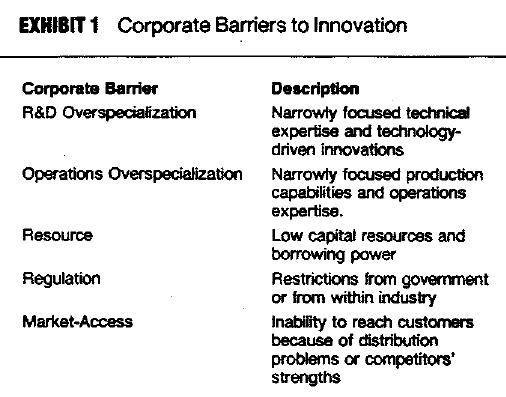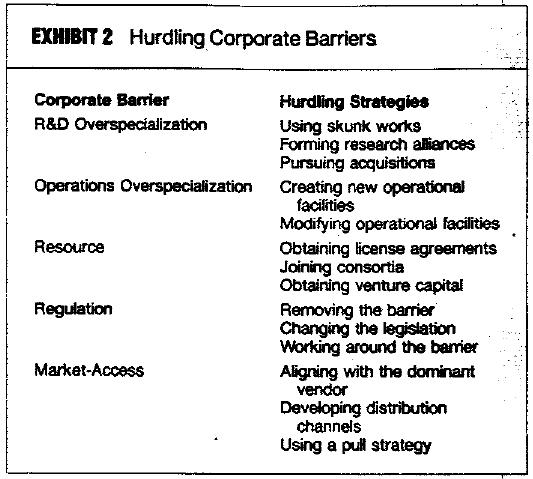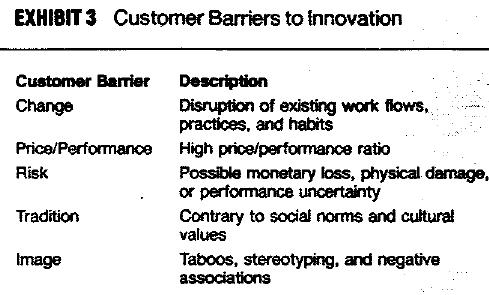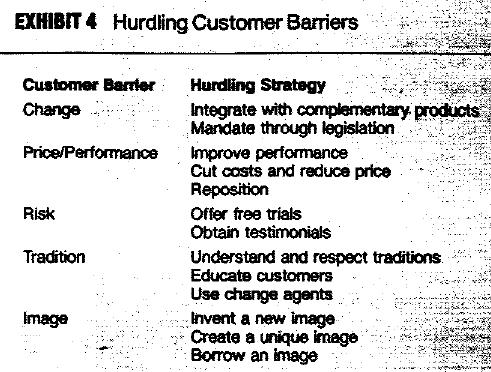S. Ram and Jagdish N. Sheth
Increasing Your Chances of Introducing Successful New Products.
With the explosive growth of new technologies, innovation will continue to be the primary source of corporate growth in the future. Technological innovations, however, encounter several corporate and customer barriers on their way to commercial success. This article describes these barriers and recommends several ways to hurdle them.
According to a survey conducted by Booz, Allen and Hamilton Inc. business executives in the US firmly believe that innovation will be the mayor source of corporate growth and profitability in the coming decades.1 Nine out of 10 executives also feel that a majority of these innovations will be based on new technologies, which create the potential for superior products at lower costs. However, as the scope for innovation increases with technological advances so does the resistance to innovation.
Innovation resistance comes from two sources. Corporations resist innovation even though their survival may be at stake, and customers resist innovation even though it could mean improved products and services. This resistance to innovation is not a cultural problem because corporate managers and consumers, especially in industrialized nations, favor innovation. They believe that technology can be harnessed far the benefit of all. The resistance arises from numerous structural barriers, which paralyze the desire to innovate. The more radical the innovation, the greater the structural barriers and therefore the greater the resistance.
Encountering and Hurdling Corporate Barriers
Most managers are aware that corporate growth and survival depend on innovation. Yet implementing innovation is often difficult because of one or more of five major categories of barriers — the R&D overspecialization barrier, the operations overspecialization barrier, the resource barrier, the regulation barrier, and the market-access barrier.
The R&D Overspecialization Barrier
As technology continues to be the primary source of innovative products and services, most organizations perceive technological specialization to be the key to successful innovation. Unfortunately, specialized knowledge is simply not versatile enough to be used for diversified products. This explains lBM’s difficulties in its attempt to move from its immediate area of specialization — computers — into the copying machine business. Xerox Faced similar problems in entering the computer industry.
The reluctance and inability of highly specialized companies to employ a breadth of technological expertise often leads them to introduce products on the basis of their current technological knowledge rather than on the basis of needs of potential customers. This tendency to generate technology-driven rather than market-driven innovations is the most dangerous consequence of the R&D overspecialization barrier. An innovative company must be flexible enough to change its established patterns of research and development to meet the demands of the marketplace, which is more difficult for a highly specialized company.
Hurdling the R&D Overspecialization Barrier
Three of the strategies that can be used to overcome this obstacle include skunk works, research alliances, and acquisitions.
Using Skunk Works. As Peters and Waterman discovered in a survey of excellent companies, one highly efficient way of encouraging innovative thinking is to organize technically talented people into an autonomous task force that is completely free from corporate rules and procedures technique succeeds because it provides creative people with the freedom to experiment outside the constraining influence of established corporate thought and behavior. Such autonomous task forces, known as skunk works, have resulted in many successful innovations.
An example is how IBM, a company whose bread and butter has been its mainframe business, succeeded in the personal computer business. The PC was based on a new technology and catered to a different type of customer: pursuing this product market thus required a different kind of expertise. IBM therefore created an autonomous product team and gave it the freedom to do whatever was necessary to acquire the expertise for success.
The task force broke some of the respected traditions in attaining success.6 The team bought microprocessor chips from an outside vendor rather than develop them in-house. It then sold the product through third-party distributors, which was contrary to IBM’s policy of direct sales to end users. The team also designed the PC to be less a system and more a set of modular components, so that customers could mix and match other manufacturers’ peripherals. Finally, it encouraged small entrepreneurs to develop applications software, an unprecedented departure from IBM culture. Yet, these creative maneuvers of the skunk works paid off for IBM.
Forming Research Alliances. It is becoming increasingly common for innovative companies to form strategic alliances with individuals and organizations that wish to share their expertise for mutual profit. Recently, Whirlpool, AT&T, RCA, General Electric. American Home Builders Association, 3M and the AMP Corp formed a strategic alliance to develop a new technology called the smart- house technology. The alliance is exploring the possibility of wiring homes on the inside so that the same outlet can be used interchangeably for telephones, computers, television, cable, and home appliances. Unlike skunk works, research alliances allow each company to maintain its established patterns of R&D. The alliances just allow these firms to share their expertise to develop a successful innovation.
Pursuing Acquisitions. Another popular way of overcoming the R&D overspecialization barrier is by acquiring, or merging with, another organization that has the desired technical know-how. For example, when IBM wanted expertise in the telecommunications industry, it acquired Rolm Corp. Unfortunately, unwise acquisitions and mergers often create problems, especially if the cultures of the two companies are incompatible. This can generate new barriers to innovation rather than eliminate the R&D overspecialization barrier.
The Operations Overspecialization Barrier
The operations overspecialization barrier is closely related to the R&D overspecialization barrier; the overspecialization simply occurs in production and assembly rather than in research and development. A company that is highly specialized in its technology is often specialized in its operations as well. Innovation in such a company often requires tremendous change from current well-established routines in materials procurement, manufacturing, and worker training.
The integrated services digital network (ISDN), an innovation in the communications industry, illustrates the problems posed by the operations overspecialization barrier. Whereas the telephone is capable of switching, transporting, and signaling with voice communications, the ISDN extends these capabilities to communications with data, pictures, and test. However, the ISDN imposes severe operational barriers.
The ISDN operation, especially at the telephone company level, is incompatible with older technologies. It requires the development of a totally new central office switch, a new private branch exchange (PBX) system, and new desktop phone sets. In addition, higher capacity transport channels may be required to fully exploit ISDNs potential, in which case it may often be desirable to replace existing copper wire with fiber optics. The ISDN also requires a high degree of integration between computer and communications technologies. Firms typically excel in one of these technologies and not the other and thus have to cope with bridging the expertise gap as well.
Hurdling the Operations Overspecialization Barrier
Strategies for overcoming this barrier include creating new operations and modifying current ones.
Creating New Operations, One effective strategy is to start a new operations facility that is physically separate from the current production facilities, workers, and management. This alternative, analogous to the skunk works concept, perm its innovative activities to flourish outside the constraining influence of established operational routines. The strategy used b General Motors for its Saturn production plant is an example.
Modifying Current Operations. A second strategy, which is most useful to those industries in which physical plant and land resources are plentiful, is the modification of existing resources to facilitate innovation. The integration of new operational procedures, however, must be performed with extreme care to avoid decreasing the efficiency of current operations. The modification can be done on an organizationwide basis or focused specifically on that part of the organization in which the technology has become outdated. For example, telephone companies are upgrading their central offices with digital switches and their local loops with fiber optics.
The Resources Barrier
Nothing discourages innovation more than insufficient funds. Few organizations have the resources required to sustain the development and marketing of innovations. The extent of the resource barrier is determined b the borrowing power of the corporation or its debt-to-equity ratio. Indeed, mans international business experts attribute Japans extremely successful innovation drive to the three to-one debt ratio (and consequently higher capital resources) generally enjoyed by Japanese companies. For most US companies, however, the resource barrier is one that needs to be surmounted.
For example, several communications suppliers are experiencing financial difficulties as they try to shift from analog to digital technologies for central office and PBX markets, In fact. ITT recently abandoned its efforts to develop the digital switch because it did not have the funds or the inclination to invest in the project. Even the German giant Siemens has decided to join with GTE to minimize the financial risk in this market. Similarly, companies in the cellular mobile telephone market have in a short period of five to six years undergone regional and national consolidation to cope with their massive capitalization needs.7
Hurdling the resource Barrier
The strategies that are available to finance an innovation and break through the resource barrier include licensing agreements, consortia and venture capital sources.
Obtaining Licensing Agreements. A common strategy is to license an innovation to other manufacturers. Sony Corp learned this approach the hard way. It pioneered the VCR technology and established the beta format. However, the beta format was not sanctioned by the Ministry of International Trade and Industries (MIT!). Most other Japanese companies decided to manufacture and market the VHS format to make it affordable to the mass market. As a result, Sony lost the VCR market. Sony, however, has learned from this experience. In the 8mm video camera market, it has licensed the technology to more than 150 companies on a worldwide basis rather than take on the full financial burden and risk for producing and marketing the innovation.
Joining Consortia. A consortium is a joint venture in which several potentially competitive yet interdependent companies get together to develop an innovative technology. The smart-house project is a very good example of a consortium. This high tech protect is simply too expensive for any one company to undertake. The consortium reduces the financial outlay required of each of the participating companies and ensures that the capital raised is used by a research group with pooled expertise. A similar consortium, called the International Telephone and Telegraph Consultative Committee (CCITT) has been organized to develop technical standards for the ISDN system.
Obtaining Venture Capital. A third approach In breaking down the resource barrier for a technological innovation is to invite venture capital. In recent years this has become a very attractive solution for generating additional finances. Wealthy individuals are constantly on the lookout for projects that offer lucrative returns on their capital. Unfortunately, this strategy does not always succeed. For one thing, venture capitalists are not committed to any one technology. They are investors merely interested in their financial returns and are willing to take higher risks than banks. However, they know from experience that it is much better to spread risk over several ventures than to invest heavily in any one venture. This usually limits the amount of capital a single yen- hire may generate. Even for the limited amount of capital they invest, venture capitalists may impose controls that are not beneficial to the venture.
The Regulation Barrier
Regulation can take several forms, and most industries are subject to at least one of them. The first type is self-regulation, which is usually limited to codes of business practice and business ethics as expressed by the industry or trade or by a professional association. The best examples of self- regulation come from such organizations as the American Medical Association and the American Bar Association.
The second type is governmental regulation of a company’s internal as well as market operations. Government regulators are concerned with product safety, occupational safety, antitrust violations, and unfair trade practices. Federal agents operate from such agencies as the Department of Justice, the Environmental Protection Agency, and the Federal Trade Commission to enforce government stipulations.
Videotex service, for example is an innovation that has been affected by the uncertainty about government regulation.8 Videotex is not a regulated technology though the Bell local telephone companies are banned from offering it on the regulated side of their business. Newspapers, for instance are concerned that videotex services may compete with them for classified ads and threaten their survival. Such concerns have slowed down product development.
A third type of regulation involves utility services such as water, gas, electricity, and telephones in which prices and products are approved by a government agency. In the case of cellular mobile phones for example the FCC regulates the business. Currently only two companies are allowed to operate in any one geographical area. The FCC however, permits pricing competition between the two carriers. Similarly, following the divestiture of AT&T. the Bell operating companies (BOCs) were restricted from entering three lines of business— information services, long-distance calls, and telephone equipment manufacture. It is because of these restrictions that the BOCs are unable to offer such innovations as electronic Yellow Pages and certain data base and transaction services. The BOCs do not have R&D. operations, or resource barriers, but the regulatory barrier has prevented these innovations from coming to fruition.
A fourth type of regulation relates to patents and trademarks. Patent rights, granted by the federal government to an innovator, can protect the innovations from poor imitations that seek to exploit a commercial opportunity. Patent protect ion has typically pissed a major role in drugs and pharmaceuticals and is becoming important in the field of biogenetics. With patent applications being made for such controversial innovations as clones the onus is on federal agencies to decide whether innovations are morally and socially acceptable even before deciding whether to grant a patent.
Hurdling the Regulation Barrier
Whatever the type of regulation encountered by an innovation, the fact remains that the more regulated an industry or company, the greater the barrier to innovation. The strategies for overcoming the regulation obstacle include removing the barrier modifying the regulation, and working around the barrier.
Removing the Barrier. The most radical solution is to abolish the regulation by legislation. This approach has been adopted effectively by one of the regional Bell companies created from the AT&T divestiture, to obtain its freedom from local regulation in several states.
Modifying the Regulation. A second strategy is to shift the regulatory jurisdiction from one agency to another. For example it is possible to transfer jurisdiction from the local government to the state government, from the state government to the federal government or from the federal government to international governments. In several countries, including the U.S. the supply of ISDN equipment such as PBXs. telephone sets, and key systems is a deregulated and highly competitive business. But in European countries, customers prefer to get this equipment from local telephone companies along with the network services. Hence other European firms inviting to compete in the business would have to change the barrier to conform to US standards, because ISDN is after all an international network that should have uniform international standards.
Working Around the Barrier. A third strategy for bypassing regulatory barriers is reorganization. In many cases, this requires forming a holding company with the freedom to offer product or service innovations that the regulated entity could not provide.
Reorganization has been used effectively in the telecommunications industry. After the AT&T divestiture, the regional Bell companies created a separate corporation in charge of all nonregulated businesses. This was done to bypass the restriction that the regulated local exchange could not subsidize nonregulated businesses such as telephone equipment cellular mobile phones. Yellow Pages advertising, private networks, maintenance and repair and international businesses.
The Market-Access Barrier
The market-access barrier refers to all impediments that keep innovations from reaching receptive customers such as inadequate physical distribution systems, strong competitors, or even customer difficulties in switching to the innovation. The market- access barrier more often creates problems for firms with low market shares than for market leaders. The smaller the market share, the greater the barrier.
A high-tech innovation that illustrates the importance of this barrier is the digital centrex. A digital centrex is designed to compete against the new generation PBX switches to handle various transactions such as intercom, party-on-hold, call transfer, three-way conference calls, and reception. The centrex system requires no special equipment at the customer’s office: regular telephones are adequate. All the electronic intelligence needed is located at the central office of the telephone company. Thus, unlike the PBX systems, the centrex requires little investment up front.
Yet, the centrex has met with serious market-access barriers. First, corporate customers who have already invested in a PBX system are reluctant to give up capitalized assets at or below book value and switch to the digital centrex. Second, the switch to the local phone company’s centrex may require reconfiguring hundreds of telephone numbers and lines, a potential nightmare. Third, customers base to decide whether to rent or buy terminals as a part of the centrex package, on the basis of investment write offs that could be obtained from outright purchase. Finally, PBX manufacturers are putting up a tough fight and attempting to upgrade customers to local area networks (LANs), a fourth-generation product with enhanced capabilities for data communications. If the upgraded PBX is as good as the digital centrex, customers who made the switch would be unhappy with their decision. The uncertainty created in evaluating the new technology has created a mark et-access barrier for the digital centrex.
Hurdling the Market Access Barrier
Three of the strategies for breaking through the market-access barrier are aligning with the dominant vendor, developing a distribution system, and using a pull strategy.
Aligning with the Dominant Vendor. If a ‘company has trouble reaching potential customers with its innovation, one strategy would be to join hands with the dominant player in the industry. For example, many software and peripheral manufacturers have learned to align with IBM by making IBM-compatible products or selling to IBM as an original equipment manufacturer.
Developing a Distribution System. A second strategy for a blocked firm is to develop its own distribution system. Although this is a very costly approach, sometimes this is the only way to break the market-access barrier. For example, small innovative companies that do not have their own dealer network use telemarketing and direct marketing programs to reach their customers. In effect, these companies have developed their own distribution systems.
Using a Pull Strategy. Finally, it is possible to hurdle the access barrier by adopting a pull strategy; that is, tapping the power of the people on the other side of the barrier—customers. A pull strategy is especially important if the customer is unsure of how to procure the product or service. Furthermore, in the case of technological innovations, the customer needs reassurance on the product’s performance and capabilities, and this can be achieved through the power of advertising, promotion, and publicity.
A list of the five corporate barriers as well as the strategies for hurdling them are shown in Exhibits 1 and 2 respectively.
Encountering and Hurdling Customer Barriers
Because customer acceptance is key to the survival of an innovation, customer barriers to innovations are more formidable than corporate barriers. Customers do not necessarily resist an innovation because they dislike it; instead, they resist the change and disruption that the innovation brings to their routine way of doing things. This is especially true when the innovation is based on a radically new technology and not just a new-and-improved version of the current technology.
Customer resistance to innovation can fall under one or more of the following five categories — change barriers, price/performance barriers, risk barriers, tradition barriers, and image barriers. The following sections discuss each of these customer barriers and ways in which the can be overcome.
The Change Barrier
Perhaps the most common reason for customer resistance to an innovation is that it is incompatible with current work flows, practices, and habits. Innovations that require significant changes in customers’ daily routine require a long market-development process. Such innovations as the television, automobile, and computer were invented years before their successful commercialization. Even if a new technology gains customer acceptance the nest save of innovations may face change barriers if it alters established customer routines.
For instance, video teleconferencing is a technological innovation that has encountered significant change barriers. This innovation allows people to meet without the stress and expenses travel.
However, a successful videoconference needs a lot of planning. Participants still have to go to specific locations away from their offices, and the time of the meeting has to be synchronized across different time zones. Documents for the meeting must be prepared and distributed ahead of time, and the flow of communications between the participants has to be managed. In addition, some managers who feel comfortable with face-to-face interaction in a meeting at corporate headquarters or at a resort facility feel uncomfortable in front of the cameras and start to behave as if they were on stage. Such change barriers have slowed down the market acceptance of videoconferencing.
Hurdling the Change Barrier
Two of the strategies available for handling the change barrier are marketing with complementary products and mandating through legislation.
Marketing with Complementary Products. The first strategy is to integrate the innovation into an existing activity or product. In other words rather than selling the product directly to the end users, it is sold to an original equipment manufacturer that makes a complementary product and sells the whole package. For example cellular mobile phone manufacturers are negotiating with automobile manufacturers to incorporate their product as an option for automobiles, just like radios, stereo systems, or air conditioners.
Mandating Through Legislation. Sometimes the change barrier can be overcome b making the adoption of the innovation mandatory through government legislation. This strategy is risky and can be used only in situations in which it is absolutely clear to the lawmakers that the customers will benefit from the innovation. The use of seat belts in automobiles has been promoted using this strategy.
The Price/Performance Barrier
The second source of customer resistance to innovations is the price, performance barrier, which is the value that an innovation offers to a customer compared with existing alternatives. Unless the innovation offers superior performance or a strong price incentive customers will not consider switching to it.
The videodisc player is an innovation that could not surmount the price/performance harrier. RCA invested more than 5600 million in this technology and hailed it as a major revolution in consumer electronics. Unfortunately, the customers disagreed and considered the videodisc player to be inferior to the emerging VCR alternative. First, the videodisc could play but not record, whereas video cassette recorders could do both. Second the programming for disc players was restricted to only what the disc producers could offer, thus limiting its potential. Videocassettes could be reused for different purposes. Finally, when the Japanese VCR producers began to drop their prices. RCA’s product had no price value either. The price/performance harrier for the innovation was too high, and therefore it failed.
Hurdling the Price/Performance Barrier
Three of the strategies that can be used to overcome the price/performance harrier are upgrading performance, cutting costs and reducing price, and positioning.
Upgrading Performance. The first strategy is to have the innovation provide significant performance value over existing alternatises.5 For example, the newer telephone sets have such features as automatic redial and memory buttons that were not available with basic telephones. Similarly, newer personal computers have higher memory capacity than older versions.
Cutting Costs and Reducing Price. A second solution is to reduce the manufacturing costs and pass on the savings to customers. For example, in the minicomputer industry, price reductions through cost savings have taken place at an extraordinary pace in less than a decade. The larger minicomputers produced by Digital, Prime, ‘and Data General have all been reduced to desktop models with more features and functions but at much lower prices compared with the older- generation machines.
Positioning. A firm can add value to its innovation by good product positioning. This approach is difficult to implement and requires a thorough analysis of the competitive market. The innovating firm must examine existing product substitutes and position the innovation in a niche or application in which it has a low price/performance ratio. For example, AT&T has always positioned itself as the premier quality corporation in the telecommunications industry and promotes all its innovations using this positioning. Despite the tremendous influx of competitors, AT&T has managed to retain a majority of its customer base, thanks to its superior positioning strategy.
The Risk Barrier
The risk barrier arises because all innovations represent uncertainty and pose side effects that cannot be anticipated. Customers, aware of these risks postpone purchase until they learn more about the innovation.
The first type of risk perceived by a customer is economic risk, IC customers have to make a considerable financial investment and fear that they may lose it, they are reluctant to adopt the innovation. Examples include such innovations as personal computers and video cameras, which constantly undergo improvements with technological advances. Many interested consumers postpone their purchase because they expect a better product with a lower price to enter the market. As companies gain experience with these technologies, they improve their products and offer them at lower prices. Ironically, it is improved company efficiency that thus creates the economic risk,
The second type of risk is physical risk; that is a harm to persons or property that may be inherent in the innovation. For example, innovations based on microwave and nuclear technology have met with resistance because of possible adverse effects on the human body. 10
A third type of risk is performance uncertainty. A customer worries that the technology may not be fully tested and developed and therefore the new product or service may not function properly. One example is electronic mail, which refers to nonvoice two-way communication between two parties using computer terminals and modems. It is equivalent to mail because the sender and the receiver need not be physically present to communicate with each other. To first-time users, this new technology poses some degree of performance uncertainty. The users are afraid of sending the wrong message to the wrong party, of having messages not reach the intended party, of failure to cope with sophisticated changes in the system, and of being considered incompetent. The difficulty is Further compounded by the relatively risk-free character of existing alternatives such as the telephone, mail, or face-to-face communication.
Hurdling the Risk Barrier
Two of the ways that customers’ perception of risk can be minimized are providing free trials and obtaining testimonials.
Providing Free Trials. The most practical method of overcoming the risk barrier is to offer the technological innovation to the customer on a trial basis with full guarantees and reassurances. However, it is not always possible to offer trials on a limited basis. For example, installing a computer system is often an irreversible decision for a company. IBM has made life easier for its customers by promising full-service support from the time of installation through the trial period and subsequent adoption. This is a strategic variation that does more than minimize risk—it eliminates it, Videotex service has also been offered by AT&T to customers on a trial basis in certain cities, and the trial has significantly decreased the risk perceived by potential customers.
Obtaining Testimonials. A second strategy to reduce perceived risk is to obtain endorsements from experts and success stories from satisfied customers.
The Tradition Barrier
An innovation is resisted when it requires customers to make changes in the cultural traditions established by a society. The greater the change, the greater the resistance.
Videotex service has laced this barrier. Because Americans love gadgets and new technologies, the innovator did not expect a tradition barrier to videotex. Yet, a vast percentage of the mass market is culturally resistant to high-tech innovations such as computers and view them as disruptive to life.
The ISDN system is another innovation that has faced tradition barriers. The corporate users have to be trained to use a single terminal for all their voice, data, and video information. The telecommunications department and the data processing department, which are typically autonomous, need to be integrated into one new department. The reporting relationships change as do the work flow and work practices. The ISON thus creates sharp variations from the established corporate procedures.
Hurdling the Tradition Barrier
Three of the strategies that can be used to grapple with tradition barriers are understanding and respecting traditions, educating customers, and using change agents.
Understanding and Respecting Traditions. Every firm must try to understand the cultural traditions honored by its customers, Most new- product failures in foreign countries can be attributed to ignorance of and arrogance about other cultures. The same is true even of products marketed in the US but targeted toss and different subcultures. Corporate managers and executives need to understand the tenacity of cultural traditions held by their customers.
Educating Customers. A second strategy for overcoming the tradition barrier is educating customers. For example, when computers were promoted as an educational tool in US schools and colleges, there was resistance because it went against the traditional blackboard-and-lecture method. But, thanks to the intervention of the government and the initiative of several leading universities, computer literacy is being propagated among even the disbelievers. In developing nations technological innovations that encounter tradition barriers have always needed government encouragement and support in the form of mass propaganda to pull through.
Using Change Agents. The third strategy in combating tradition barriers is to employ change agents. This is also referred to as opinion leadership or leading-edge strategy. Change agents are the large. Influential customers who endorse the innovation and encourage other customers to adopt it. IBM has consistently used its leading-edge customers such as banks and brokerage and insurance firms to invest early in its new technologies and let the smaller customers be influenced by these early users. The same strategy has been used by Xerox in office automation and AT&T in Videotex service. Change agents are the right customers to pursue initially because they are usually more nflov5tive and find it easier to break away from tradition.
The Image Barrier
Innovations can acquire an identity solely from their origins—product class industry, and country. If these associations are unfavorable as a result of stereotyped thinking, they create barriers to adopt ion. Image is by definition more perceptual than real. Image barriers are typically built from violated social taboos, stigmas associated with new technologies or deep-seated psychological forces that may be aroused by the innovation.
An innovation that has encountered image barriers is the lifeline telephone service. The lifeline service is primarily designed for the poor who can no longer afford the rising costs of the basic telephone service. The lifeline service enables each residential customer to make a minimum number of calls, which includes emergency calls for police, fire, and ambulance service. The customer must pay for each local call beyond this minimum. In some states such as California, this service is mandated law to ensure that no one is deprived of the basic telephone facility because of a lack of funds.
The basic problem, though, is that customers have to declare themselves poor in order to become eligible for this service. Admitting poverty, however, has negative connotations. It suggests a defeatist attitude and a lack of motivation. It creates suspicions of fraud. Using the lifeline service creates a sense of guilt and shame that has been associated with other social subsidized services such as welfare food stamps, and public housing, resulting in an Image barrier to the innovative telephone service.
Hurdling the Image Barrier
Three of the strategies that can be used to overcome the image barrier are correcting the image. creating a unique image and borrowing an image people have about Korean products, thus hoping to offset the negative customer perception.
Correcting the Image. The first strategy is to make fun of the image and suggest how silly it is for people to believe in such stereotype. Goldstar, the Korean multibillion-dollar corporation dealing in electronic goods, jokes about the negative image
Creating a Unique Image. The second strategy is to create a unique image for the new product or service. Steve Jobs, the founder of Apple Computers, did lust that. Apple is still the symbol of the small innovative firm that came through with a quality innovation.
Borrowing an Image. The third solution to the image barrier problem is to consciously associate the new product or service with a person or ob1ect with a positive public image. Offshore manufacturers of electronic goods and office equipment sell their products through well-known corporations such as General Electric and Savin, thus borrowing the image associated with these firms.
A list of the five customer barriers as well as the strategies for hurdling them are shown in Exhibits 3 and 4 respectively.
Sustaining Growth
Technological innovations will continue to be the source of corporate growth and survival worldwide. This article has identified major corporate and customer barriers that create structural discontinuity for technological innovations as well as strategies to hurdle those barriers.11 With the life cycles of technologies becoming shorter and competition becoming more intense, successful innovation has assumed great importance. Therefore, the corporation that makes an early start at identifying and breaking the major barriers to its innovations will gain a competitive edge.









